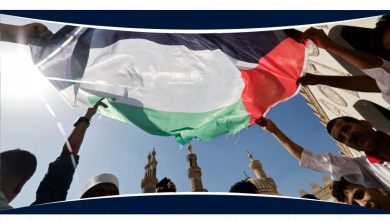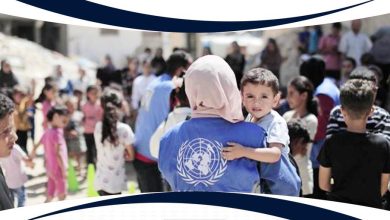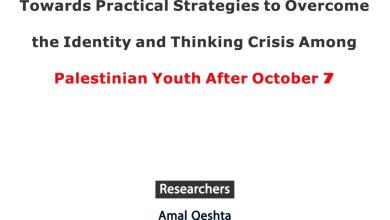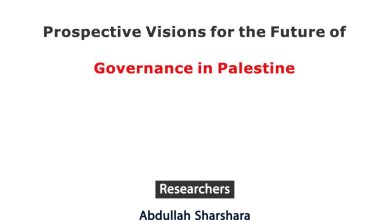International Aid to the Palestinians: Between Politicization and Development
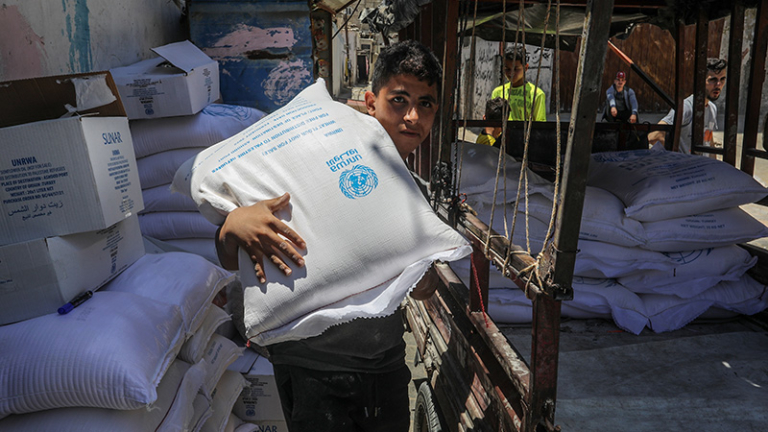
![]() Omar Shaban
Omar Shaban
Following the signing of the Oslo Accords between Israel and the Palestine Liberation Organization in 1993, an international conference was held in Washington to assure the financial solvency of the newly-established Palestinian National Authority (PA). Key goals at the time included financing economic development in the occupied West Bank and the Gaza Strip, contributing to stability in the Middle East, and introducing liberalized markets while also working to sustain democratic institutions and protect human rights. According to figures compiled by the Organization for Economic Cooperation and Development, aid to Palestinians amounted to more than $40 billion between 1994 and 2020. The largest portion of this assistance (35.4 percent) went to support the PA budget, while the rest was allocated to various services and economic sectors in the Palestinian territories. The bulk of the aid—nearly 72 percent—came from ten donors: the European Union (18.9), the United States (14.2), Saudi Arabia (9.9), Germany (5.8), the United Arab Emirates (5.2), Norway (4.8), United Kingdom (4.3), the World Bank (3.2), Japan (2.9), and France (2.7).
Non-Arab Donors
Non-Arab donors provided close to 77 percent of all aid for the period in question. Notable donors were:
The European Union: Driven by a desire to help implement the two-state solution and to also address serious socioeconomic needs in Palestinian society, the European Union regularly directs aid to several channels, including the institutions of the PA, the United Nations Relief and Works Agency for Palestine Refugees in the Near East (UNRWA), healthcare and social welfare organizations, and other groups working on humanitarian, educational, and other social issues. Following a partial suspension of funds in 2020—which was intended to force changes in Palestinian educational curricula—the EU released the roughly €215 million in aid that it had been withholding. And on average, the EU provides more than €600 million a year in aid to the Palestinians.
The United States: American aid to the Palestinians has been influenced over the years by the vicissitudes of US-Israeli relations, as well as by the central role Washington has played in steering what little remains of a peace process between Israel and Palestine. Nonetheless, the US is the second largest source of aid to the Palestinians. Following a drastic reduction of American aid during the Trump Administration—which then President Donald Trump attempted to use as leverage to force the Palestinians to accept his so-called “deal of the century” peace plan—the Biden Administration resumed funding in 2021, to the tune of almost $250 million. Importantly, this tranche of aid included $150 million for UNRWA, which provides for millions of Palestinian refugees living both under Israeli control and in neighboring Arab countries. During his recent trip to Palestine, President Joe Biden announced an additional aid package of $316 million, $201 million of which was allocated to UNRWA. A multi-year contribution of $100 million for East Jerusalem hospitals was also included in the package. Although administration officials have emphasized the need to ameliorate the dire economic conditions in Palestine, steps to deal with the issue must also include attention to Palestinians’ political and national rights.
Following a drastic reduction of American aid during the Trump Administration in order to force the Palestinians to accept the so-called “deal of the century” peace plan, the Biden Administration resumed funding in 2021, to the tune of almost $250 million.
Individual Countries: Germany, Norway, the United Kingdom, France, and Japan are among the countries that have been most committed to helping the Palestinians. Their combined contributions amounted to more than 20 percent of all aid between 1994 and 2020. Their chief concern has been to assist the PA, given that it is the only internationally-recognized Palestinian political entity responsible for administering the occupied Palestinian territories.
The World Bank: As the international financial institution responsible for aiding economic development, the World Bank has provided the Palestinians with both assistance and expertise. Its contributions to the Palestinian economy during the period in question totaled $1.3 billion (or 3.2 percent of the total). The World Bank also exerts significant influence on the aid process, helping set the donor aid agenda and assisting with the management of donated funds.
Arab Donors
A look at the aid distribution map shows that five Arab countries provided the bulk of Arab aid to the Palestinians between 1994 and 2020, totaling some $8.5 billion. All of these countries are oil- and gas-rich, which not only gives them a central role in ensuring Palestinian well-being, but also enhances their potential to impact the Palestinian cause. The top donor during this period was Saudi Arabia at $4 billion, followed by the UAE ($2.1 billion), Algeria ($908 million), Qatar ($766 million), and Kuwait ($758 million). But in 2020, Arab assistance dropped dramatically, ostensibly because of economic considerations due to the COVID-19 pandemic. Saudi aid, for example, dropped by just over 77 percent compared to the previous year, while Algerian aid dried up completely. However, some attributed the decline—at least in Saudi aid—to political considerations connected with the Trump Administration’s efforts to force the PA to accept its peace plan. But regardless of social or political considerations, the Arab world’s provision for the well-being of the Palestinians has long been essential, linked as it is with Arab states’ declared solidarity with the Palestinian cause and their insistence on the importance of addressing Palestinians’ political and national rights.
The top Arab donor from 1994 to 2020 was Saudi Arabia at $4 billion, followed by the UAE ($2.1 billion), Algeria ($908 million), Qatar ($766 million), and Kuwait ($758 million).
One factor influencing both international and Arab financial support to Palestinians is the current political split between the West Bank and the Gaza Strip, which began when Hamas took over governance in Gaza in 2007. As Nathan Brown writes, the division caused a reduction in donors’ contributions because many did not want to be accused by Israel or the United States of aiding Hamas, which the two countries consider a terrorist organization. Instead, Brown argues, “Attention, diplomatic energy, and funds shifted elsewhere (primarily to the West Bank and the PA there).” But the PA did not neglect the Gaza Strip after splitting with Hamas, and provides part of the aid supplied to Gaza. Meanwhile, Qatar became—for humanitarian as well as political reasons—the main provider for the Gaza Strip. From 2012 to 2021, the small peninsular nation gave the Gaza strip $1.3 billion, including $500 million following the Israeli assault on Gaza in May 2021.
What Impact Does International Aid Leave?
The question of what impact international aid makes in Palestine has weighed on politicians, activists, and ordinary Palestinians. In a prescient analysis, Yara Asi argues that since the signing of the Oslo Accords, “nobody seems to know what the long-term purpose of aid in Palestine is anymore.” She poses an important question, asking whether the aid is meant “to support institution building for a two-state solution, or to provide decades of emergency funding for a population experiencing ongoing violence and deprivation.” Asi posits that the two-state solution no longer appears realistic and writes that despite continued aid, “less than half of Palestinian households were food secure in 2020,” while at the same time poverty continues to increase and unemployment remains high in both the West Bank and the Gaza Strip. In addition, the World Bank reported last May that despite all efforts to address the PA’s fiscal deficit, the authority remains indebted to the private sector, its pension fund, and domestic borrowing.
Much of the aid that Palestinians receive from the Arab world and the international community is governed by either solidarity politics or by political considerations focused on the reality of the Palestinian-Israeli conflict.
Given these considerations, a few important comments are necessary when it comes to international aid to the Palestinian people, and especially to the portion provided for the PA’s general budget. First, much of the aid that Palestinians receive from the Arab world and the international community is governed by either solidarity politics or by political considerations focused on the reality of the Palestinian-Israeli conflict. In donors’ calculations, an emphasis on supporting the PA so that it can continue to assure peace and stability far outweighs the importance of development plans that could potentially put the aid to better use. As a result, most Palestinians do not feel much affinity with international donors, from whose assistance they rarely benefit directly. Second, by its very nature, foreign aid is promised without guarantees that the funds will be delivered. This instability impacts the PA’s ability to predict the origin, amount, and directed use of such aid, making public finance management in the occupied Palestinian territories increasingly unpredictable, and thereby hindering the PA’s efforts to create and implement development initiatives.
Third, even when economic development is a priority for international donors, the increasingly complicated nature of the Palestinian-Israeli conflict makes the implementation of development projects difficult to achieve. This in turn leads donors to allocate most of their aid to addressing urgent humanitarian needs and the PA’s budget deficit. Fourth, and most importantly, the reality of Israel’s occupation of Palestinian land and the political and economic control it wields over Palestinian institutions causes a good portion of aid intended for the Palestinians to instead be funneled into the Israeli economy, which renders the funds useless for the PA or the Palestinian economy at large. Indeed, the benefits Israel enjoys from its colonization of the West Bank and its blockade of Gaza seriously limit the scope of what Palestinians are able to accomplish with the international aid they receive.
Aid Without Development
In light of this analysis of the nature, purpose, size, and impact of international aid to the Palestinians, the conclusion must be drawn that since the establishment of the PA, international aid has failed to achieve the Palestinians’ aspiration of placing their economy on the path of economic growth and sustainable development. This failure is due to the deadlock in the Palestinian-Israeli peace process and to the recurrence of dramatic political and security developments. It is also caused by Israel’s policies and actions, which include its continued control over large parts of the Palestinian territories, its imposition of severe restrictions on the freedom of movement of both people and goods, and its periodic military attacks on the Gaza Strip, all of which have led to changes in both the scope and focus of international aid. These factors continue to lead international donors to focus on relief and on addressing imbalances and distortions that have arisen as a result of blockade, division, and repeated Israeli attacks instead of working to bring about the real development that the Palestinians seek to achieve.

